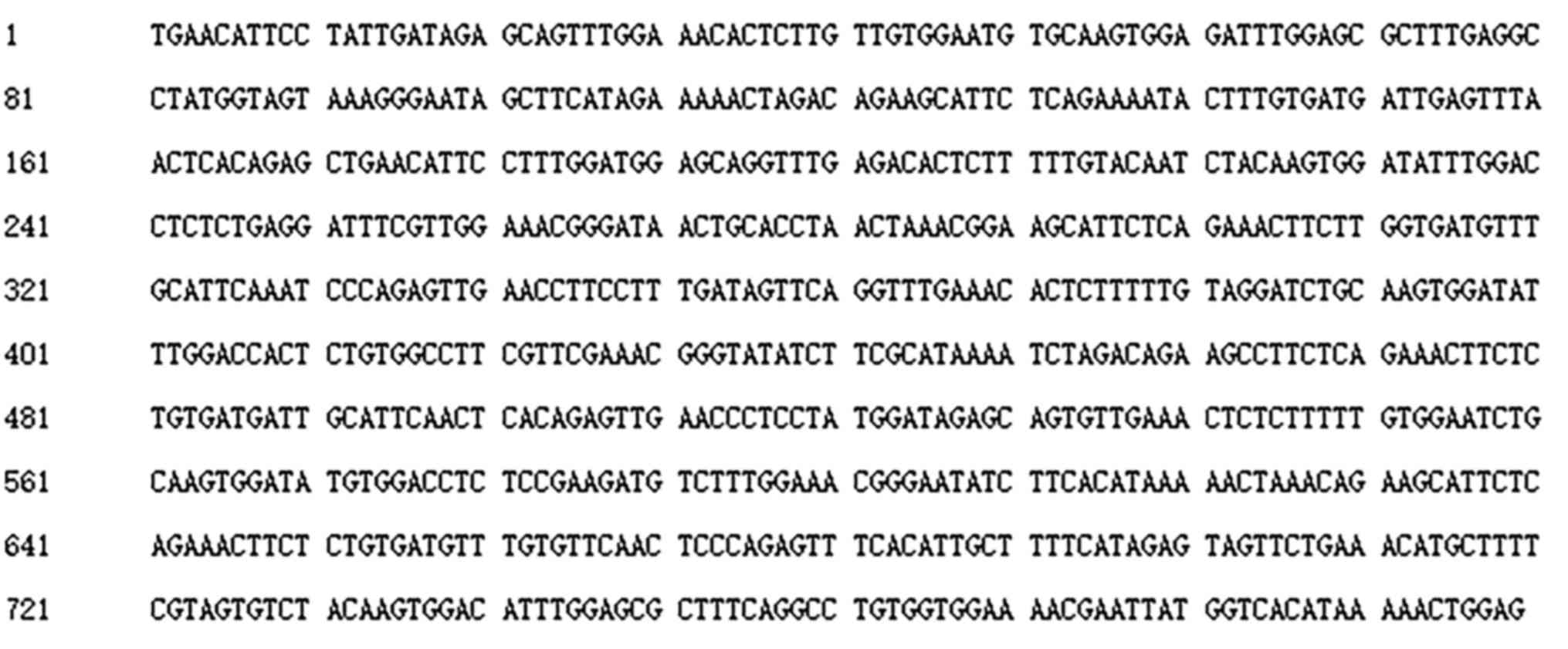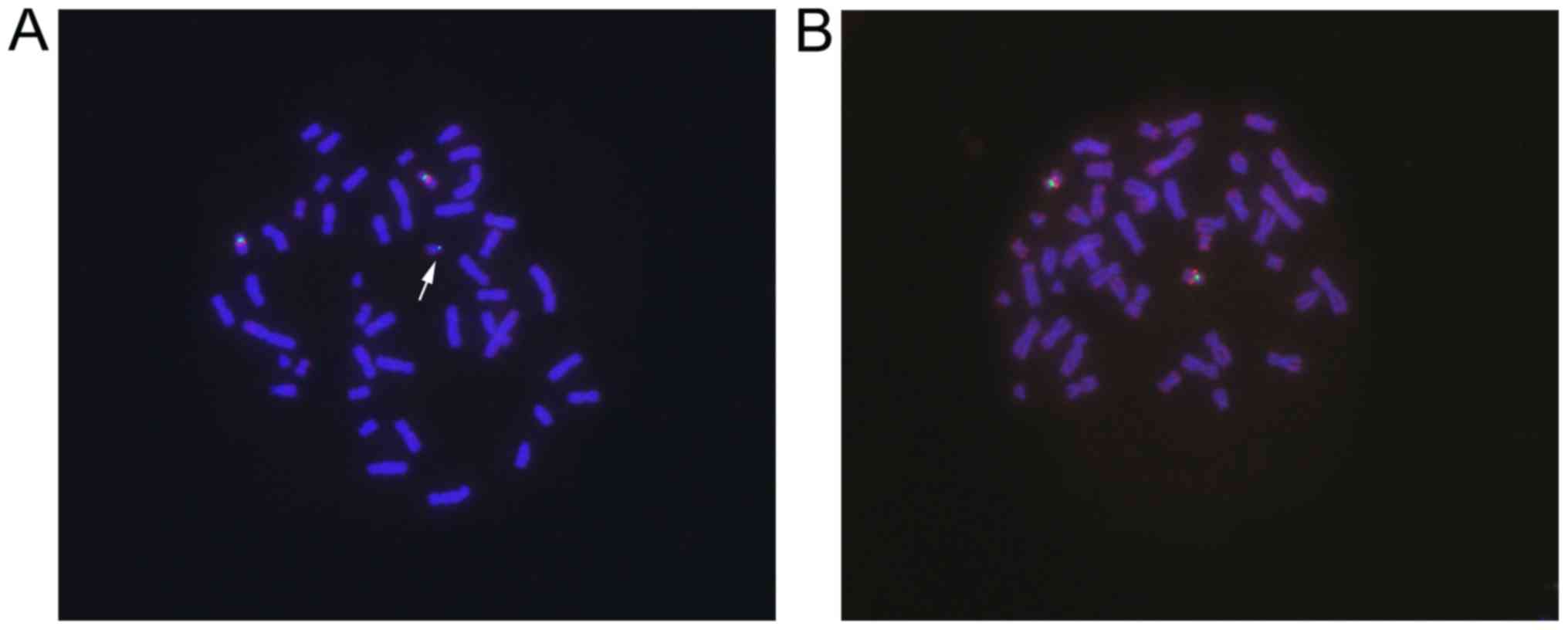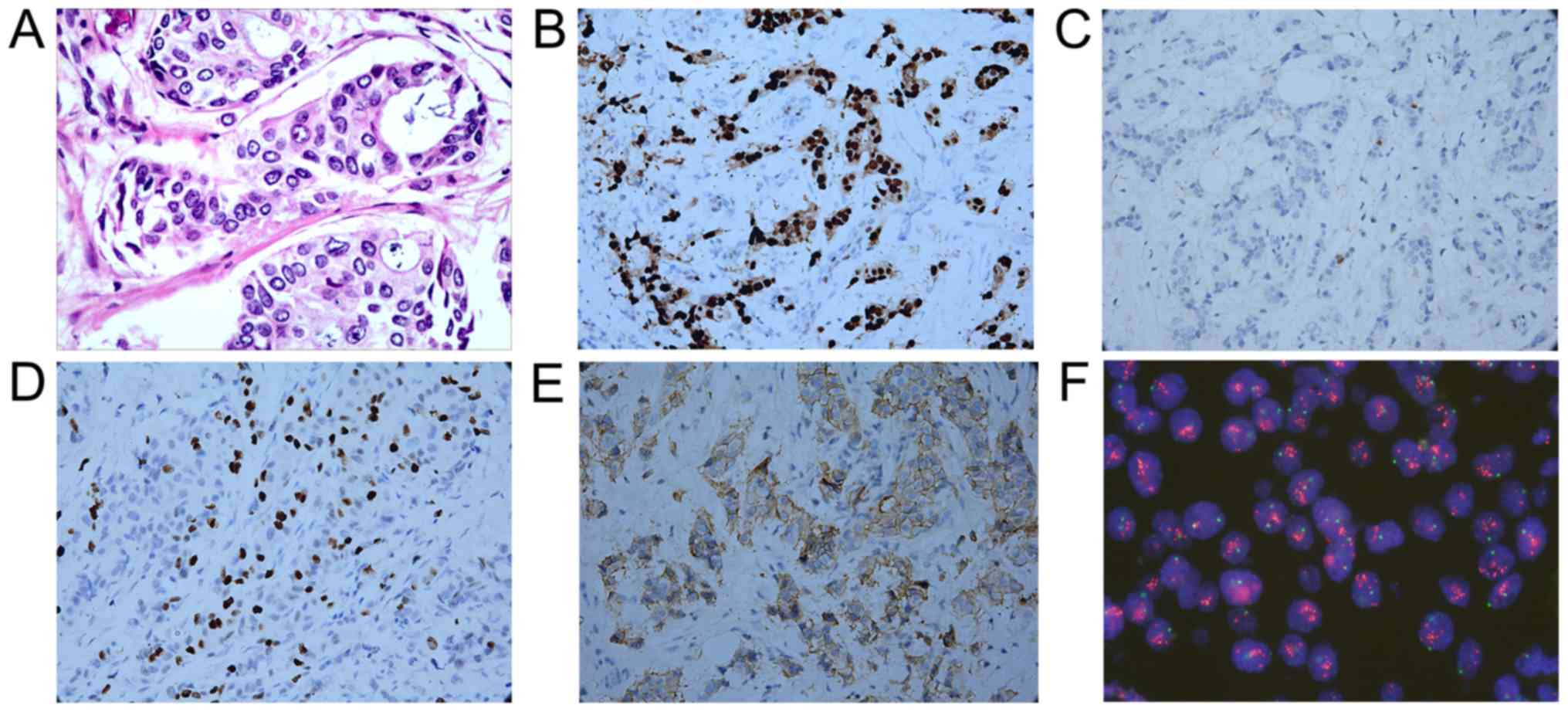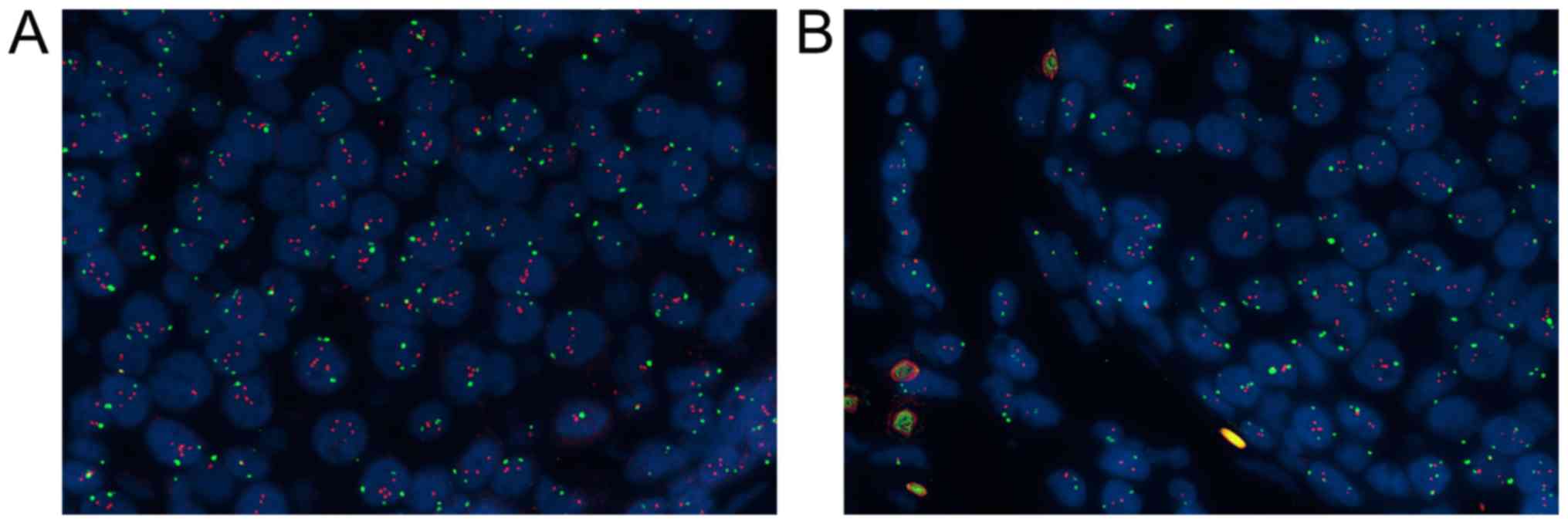|
1
|
Krishnamurti U and Silverman JF: HER2 in
breast cancer: A review and update. Adv Anat Pathol. 21:100–107.
2014. View Article : Google Scholar : PubMed/NCBI
|
|
2
|
Slamon DJ, Clark GM, Wong SG, Levin WJ,
Ullrich A and McGuire WL: Human breast cancer: Correlation of
relapse and survival with amplification of the HER-2/neu oncogene.
Science. 235:177–182. 1987. View Article : Google Scholar : PubMed/NCBI
|
|
3
|
Lal P, Salazar PA, Hudis CA, Ladanyi M and
Chen B: HER-2 testing in breast cancer using immunohistochemical
analysis and fluorescence in situ hybridization: A
single-institution experience of 2,279 cases and comparison of
dual-color and single-color scoring. Am J Clin Pathol. 121:631–636.
2004. View Article : Google Scholar : PubMed/NCBI
|
|
4
|
Varga Z, Noske A, Ramach C, Padberg B and
Moch H: Assessment of HER2 status in breast cancer: Overall
positivity rate and accuracy by fluorescence in situ hybridization
and immunohistochemistry in a single institution over 12 years: A
quality control study. BMC Cancer. 13:6152013. View Article : Google Scholar : PubMed/NCBI
|
|
5
|
Esteva FJ and Hortobagyi GN: Prognostic
molecular markers in early breast cancer. Breast Cancer Res.
6:109–118. 2004. View
Article : Google Scholar : PubMed/NCBI
|
|
6
|
Tandon AK, Clark GM, Chamness GC, Ullrich
A and McGuire WL: HER-2/neu oncogene protein and prognosis in
breast cancer. J Clin Oncol. 7:1120–1128. 1989. View Article : Google Scholar : PubMed/NCBI
|
|
7
|
Pritchard KI, Shepherd LE, O'Malley FP,
Andrulis IL, Tu D, Bramwell VH and Levine MN; National Cancer
Institute of Canada Clinical Trials Group, : HER2 and
responsiveness of breast cancer to adjuvant chemotherapy. N Engl J
Med. 354:2103–2111. 2006. View Article : Google Scholar : PubMed/NCBI
|
|
8
|
Ménard S, Valagussa P, Pilotti S, Gianni
L, Biganzoli E, Boracchi P, Tomasic G, Casalini P, Marubini E,
Colnaghi MI, et al: Response to cyclophosphamide, methotrexate, and
fluorouracil in lymph node-positive breast cancer according to HER2
overexpression and other tumor biologic variables. J Clin Oncol.
19:329–335. 2001. View Article : Google Scholar : PubMed/NCBI
|
|
9
|
De Laurentiis M, Arpino G, Massarelli E,
Ruggiero A, Carlomagno C, Ciardiello F, Tortora G, D'Agostino D,
Caputo F, Cancello G, et al: A meta-analysis on the interaction
between HER-2 expression and response to endocrine treatment in
advanced breast cancer. Clin Cancer Res. 11:4741–4748. 2005.
View Article : Google Scholar : PubMed/NCBI
|
|
10
|
Guiu S, Gauthier M, Coudert B, Bonnetain
F, Favier L, Ladoire S, Tixier H, Guiu B, Penault-Llorca F, Ettore
F, et al: Pathological complete response and survival according to
the level of HER-2 amplification after trastuzumab-based
neoadjuvant therapy for breast cancer. Br J Cancer. 103:1335–1342.
2010. View Article : Google Scholar : PubMed/NCBI
|
|
11
|
Saini KS, Azim HA Jr, Metzger-Filho O, Loi
S, Sotiriou C, de Azambuja E and Piccart M: Beyond trastuzumab: new
treatment options for HER2-positive breast cancer. Breast. 20
(Suppl 3):S20–S27. 2011. View Article : Google Scholar : PubMed/NCBI
|
|
12
|
Wolff AC, Hammond ME, Hicks DG, Dowsett M,
McShane LM, Allison KH, Allred DC, Bartlett JM, Bilous M,
Fitzgibbons P, et al: Recommendations for human epidermal growth
factor receptor 2 testing in breast cancer: American Society of
Clinical Oncology/College of American Pathologists clinical
practice guideline update. J Clin Oncol. 31:3997–4013. 2013.
View Article : Google Scholar : PubMed/NCBI
|
|
13
|
Rosa FE, Santos RM, Rogatto SR and
Domingues MA: Chromogenic in situ hybridization compared with other
approaches to evaluate HER2/neu status in breast carcinomas. Braz J
Med Biol Res. 46:207–216. 2013. View Article : Google Scholar : PubMed/NCBI
|
|
14
|
Dal Lago L, Durbecq V, Desmedt C, Salgado
R, Verjat T, Lespagnard L, Ma Y, Veys I, Di Leo A, Sotiriou C, et
al: Correction for chromosome-17 is critical for the determination
of true Her-2/neu gene amplification status in breast cancer. Mol
Cancer Ther. 5:2572–2579. 2006. View Article : Google Scholar : PubMed/NCBI
|
|
15
|
Vanden Bempt I, Van Loo P, Drijkoningen M,
Neven P, Smeets A, Christiaens MR, Paridaens R and De Wolf-Peeters
C: Polysomy 17 in breast cancer: Clinicopathologic significance and
impact on HER-2 testing. J Clin Oncol. 26:4869–4874. 2008.
View Article : Google Scholar : PubMed/NCBI
|
|
16
|
Vanden Bempt I, Drijkoningen M and De
Wolf-Peeters C: The complexity of genotypic alterations underlying
HER2-positive breast cancer: An explanation for its clinical
heterogeneity. Curr Opin Oncol. 19:552–557. 2007. View Article : Google Scholar : PubMed/NCBI
|
|
17
|
Gunn S, Yeh IT, Lytvak I, Tirtorahardjo B,
Dzidic N, Zadeh S, Kim J, McCaskill C, Lim L, Gorre M and Mohammed
M: Clinical array-based karyotyping of breast cancer with equivocal
HER2 status resolves gene copy number and reveals chromosome 17
complexity. BMC Cancer. 10:3962010. View Article : Google Scholar : PubMed/NCBI
|
|
18
|
Forozan F, Mahlamäki EH, Monni O, Chen Y,
Veldman R, Jiang Y, Gooden GC, Ethier SP, Kallioniemi A and
Kallioniemi OP: Comparative genomic hybridization analysis of 38
breast cancer cell lines: A basis for interpreting complementary
DNA microarray data. Cancer Res. 60:4519–4525. 2000.PubMed/NCBI
|
|
19
|
Gown AM, Goldstein LC, Barry TS, Kussick
SJ, Kandalaft PL, Kim PM and Tse CC: High concordance between
immunohistochemistry and fluorescence in situ hybridization testing
for HER2 status in breast cancer requires a normalized IHC scoring
system. Mod Pathol. 21:1271–1277. 2008. View Article : Google Scholar : PubMed/NCBI
|
|
20
|
Waye JS and Willard HF: Structure,
organization, and sequence of alpha satellite DNA from human
chromosome 17: Evidence for evolution by unequal crossing-over and
an ancestral pentamer repeat shared with the human X chromosome.
Mol Cell Biol. 6:3156–3165. 1986. View Article : Google Scholar : PubMed/NCBI
|
|
21
|
Choo KH, Brown R, Webb G, Craig IW and
Filby RG: Genomic organization of human centromeric alpha satellite
DNA: Characterization of a chromosome 17 alpha satellite sequence.
DNA. 6:297–305. 1987. View Article : Google Scholar : PubMed/NCBI
|
|
22
|
Gonzalez Garcia JR and Meza-Espinoza JP:
Use of the international system for human cytogenetic nomenclature
(ISCN). Blood. 108:3952–3953; author reply 3953. 2006. View Article : Google Scholar : PubMed/NCBI
|
|
23
|
Gao M, Pang H, Zhao YH, Hua J, Tong D,
Zhao H, Liu Y, Zhao Y, Zhang M, Yan XJ, et al: Karyotype analysis
in large sample cases from Shenyang Women's and Children's
hospital: A study of 16,294 male infertility patients. Andrologia.
49:2017. View Article : Google Scholar
|
|
24
|
Espinosa R III and Le Beau MM: Gene
mapping by FISH. Methods Mol Biol. 68:53–76. 1997.PubMed/NCBI
|
|
25
|
Visscher DW, Wallis T and Ritchie CA:
Detection of chromosome aneuploidy in breast lesions with
fluorescence in situ hybridization: comparison of whole nuclei to
thin tissue sections and correlation with flow cytometric DNA
analysis. Cytometry. 21:95–100. 1995. View Article : Google Scholar : PubMed/NCBI
|
|
26
|
Cheng SS and Cheng YC: An ordered relation
between the ANOVA estimator of the intraclass correlation and a
kappa-type statistic in binary data. Stat Probab Lett. 38:275–280.
2010. View Article : Google Scholar
|
|
27
|
Pathmanathan N and Bilous AM: HER2 testing
in breast cancer: An overview of current techniques and recent
developments. Pathology. 44:587–595. 2012. View Article : Google Scholar : PubMed/NCBI
|
|
28
|
O'Grady A, Allen D, Happerfield L, Johnson
N, Provenzano E, Pinder SE, Tee L, Gu M and Kay EW: An
immunohistochemical and fluorescence in situ hybridization-based
comparison between the Oracle HER2 Bond Immunohistochemical System,
Dako HercepTest, and Vysis PathVysion HER2 FISH using both
commercially validated and modified ASCO/CAP and United Kingdom
HER2 IHC scoring guidelines. Appl Immunohistochem Mol Morphol.
18:489–493. 2010. View Article : Google Scholar : PubMed/NCBI
|
|
29
|
Yoon N, Do IG and Cho EY: Analysis of HER2
status in breast carcinoma by fully automated HER2 fluorescence in
situ hybridization (FISH): Comparison of two immunohistochemical
tests and manual FISH. APMIS. 122:755–760. 2014. View Article : Google Scholar : PubMed/NCBI
|
|
30
|
Hyun CL, Lee HE, Kim KS, Kim SW, Kim JH,
Choe G and Park SY: The effect of chromosome 17 polysomy on
HER-2/neu status in breast cancer. J Clin Pathol. 61:317–321. 2008.
View Article : Google Scholar : PubMed/NCBI
|
|
31
|
Marchiò C, Lambros MB, Gugliotta P, Di
Cantogno LV, Botta C, Pasini B, Tan DS, Mackay A, Fenwick K, Tamber
N, et al: Does chromosome 17 centromere copy number predict
polysomy in breast cancer? A fluorescence in situ hybridization and
microarray-based CGH analysis. J Pathol. 219:16–24. 2009.
View Article : Google Scholar : PubMed/NCBI
|
|
32
|
Moelans CB, de Weger RA and van Diest PJ:
Absence of chromosome 17 polysomy in breast cancer: Analysis by
CEP17 chromogenic in situ hybridization and multiplex
ligation-dependent probe amplification. Breast Cancer Res Treat.
120:1–7. 2010. View Article : Google Scholar : PubMed/NCBI
|
|
33
|
Yeh IT, Martin MA, Robetorye RS, Bolla AR,
McCaskill C, Shah RK, Gorre ME, Mohammed MS and Gunn SR: Clinical
validation of an array CGH test for HER2 status in breast cancer
reveals that polysomy 17 is a rare event. Mod Pathol. 22:1169–1175.
2009. View Article : Google Scholar : PubMed/NCBI
|
|
34
|
Bartley AN, Washington MK, Colasacco C,
Ventura CB, Ismaila N, Benson AB III, Carrato A, Gulley ML, Jain D,
Kakar S, et al: HER2 testing and clinical decision making in
gastroesophageal adenocarcinoma: Guideline from the college of
American Pathologists, American Society for clinical pathology, and
the American Society of clinical oncology. J Clin Oncol.
35:446–464. 2017. View Article : Google Scholar : PubMed/NCBI
|
|
35
|
Tse CH, Hwang HC, Goldstein LC, Kandalaft
PL, Wiley JC, Kussick SJ and Gown AM: Determining true HER2 gene
status in breast cancers with polysomy by using alternative
chromosome 17 reference genes: Implications for anti-HER2 targeted
therapy. J Clin Oncol. 29:4168–4174. 2011. View Article : Google Scholar : PubMed/NCBI
|
|
36
|
Jang MH, Kim EJ, Kim HJ, Chung YR and Park
SY: Assessment of HER2 status in invasive breast cancers with
increased centromere 17 copy number. Breast Cancer Res Treat.
153:67–77. 2015. View Article : Google Scholar : PubMed/NCBI
|
|
37
|
Sneige N, Hess KR, Multani AS, Gong Y and
Ibrahim NK: Prognostic significance of equivocal human epidermal
growth factor receptor 2 results and clinical utility of
alternative chromosome 17 genes in patients with invasive breast
cancer: A cohort study. Cancer. 123:1115–1123. 2017. View Article : Google Scholar : PubMed/NCBI
|
|
38
|
Donaldson AR, Shetty S, Wang Z, Rivera CL,
Portier BP, Budd GT, Downs-Kelly E, Lanigan CP and Calhoun BC:
Impact of an alternative chromosome 17 probe and the 2013 American
Society of Clinical Oncology and College of American Pathologists
guidelines on fluorescence in situ hybridization for the
determination of HER2 gene amplification in breast cancer. Cancer.
123:2230–2239. 2017. View Article : Google Scholar : PubMed/NCBI
|


















